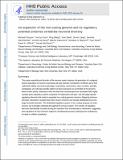| dc.contributor.author | Closser, Michael | |
| dc.contributor.author | Guo, Yuchun | |
| dc.contributor.author | Wang, Ping | |
| dc.contributor.author | Patel, Tulsi | |
| dc.contributor.author | Jang, Sumin | |
| dc.contributor.author | Hammelman, Jennifer | |
| dc.contributor.author | De Nooij, Joriene C | |
| dc.contributor.author | Kopunova, Rachel | |
| dc.contributor.author | Mazzoni, Esteban O | |
| dc.contributor.author | Ruan, Yijun | |
| dc.contributor.author | Gifford, David K | |
| dc.contributor.author | Wichterle, Hynek | |
| dc.date.accessioned | 2023-01-10T18:23:06Z | |
| dc.date.available | 2023-01-10T18:23:06Z | |
| dc.date.issued | 2022 | |
| dc.identifier.uri | https://hdl.handle.net/1721.1/147050 | |
| dc.description.abstract | Proper assembly and function of the nervous system requires the generation of a uniquely diverse population of neurons expressing a cell-type-specific combination of effector genes that collectively define neuronal morphology, connectivity, and function. How countless partially overlapping but cell-type-specific patterns of gene expression are controlled at the genomic level remains poorly understood. Here we show that neuronal genes are associated with highly complex gene regulatory systems composed of independent cell-type- and cell-stage-specific regulatory elements that reside in expanded non-coding genomic domains. Mapping enhancer-promoter interactions revealed that motor neuron enhancers are broadly distributed across the large chromatin domains. This distributed regulatory architecture is not a unique property of motor neurons but is employed throughout the nervous system. The number of regulatory elements increased dramatically during the transition from invertebrates to vertebrates, suggesting that acquisition of new enhancers might be a fundamental process underlying the evolutionary increase in cellular complexity. | en_US |
| dc.language.iso | en | |
| dc.publisher | Elsevier BV | en_US |
| dc.relation.isversionof | 10.1016/J.NEURON.2021.10.014 | en_US |
| dc.rights | Creative Commons Attribution-NonCommercial-NoDerivs License | en_US |
| dc.rights.uri | http://creativecommons.org/licenses/by-nc-nd/4.0/ | en_US |
| dc.source | PMC | en_US |
| dc.title | An expansion of the non-coding genome and its regulatory potential underlies vertebrate neuronal diversity | en_US |
| dc.type | Article | en_US |
| dc.identifier.citation | Closser, Michael, Guo, Yuchun, Wang, Ping, Patel, Tulsi, Jang, Sumin et al. 2022. "An expansion of the non-coding genome and its regulatory potential underlies vertebrate neuronal diversity." Neuron, 110 (1). | |
| dc.contributor.department | Massachusetts Institute of Technology. Computer Science and Artificial Intelligence Laboratory | |
| dc.relation.journal | Neuron | en_US |
| dc.eprint.version | Author's final manuscript | en_US |
| dc.type.uri | http://purl.org/eprint/type/JournalArticle | en_US |
| eprint.status | http://purl.org/eprint/status/PeerReviewed | en_US |
| dc.date.updated | 2023-01-10T18:17:49Z | |
| dspace.orderedauthors | Closser, M; Guo, Y; Wang, P; Patel, T; Jang, S; Hammelman, J; De Nooij, JC; Kopunova, R; Mazzoni, EO; Ruan, Y; Gifford, DK; Wichterle, H | en_US |
| dspace.date.submission | 2023-01-10T18:17:52Z | |
| mit.journal.volume | 110 | en_US |
| mit.journal.issue | 1 | en_US |
| mit.license | PUBLISHER_CC | |
| mit.metadata.status | Authority Work and Publication Information Needed | en_US |
